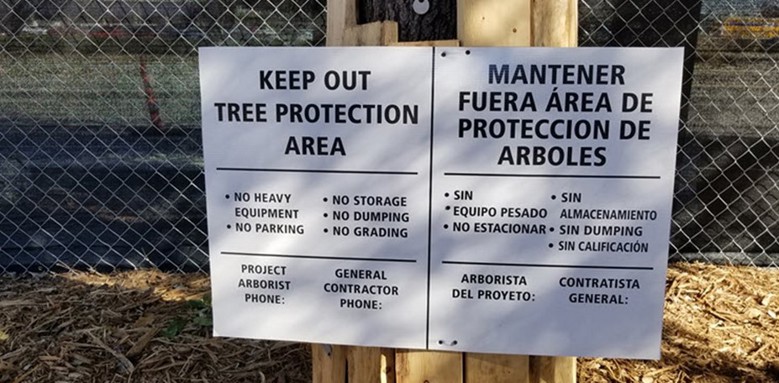Guidelines for Tree Preservation During Construction


Published April 1, 2012, By RUSSELL PETERS
The following guidelines apply to construction activities in and around root zones of existing trees. Please understand that the most critical roots for a tree, the fine feeder roots, occupy primarily the top 12 inches of soil with structural or anchoring roots occupying areas from 12 to 30 inches and rarely deeper than two to two and a half feet, depending on soil type, soil structure, and tilth.
- Establish rigid barriers, preferably chain link fencing, at or beyond the drip line to establish protected root zones. Often time’s groups of trees are involved and barriers may be erected to surround several trees at a time. These areas should have lockable walk gates with limited access for; periodic irrigation, deep root fertilization/aeration, and maintaining mulch depth. I understand a contractor must access a minimum area to work and access to certain sensitive areas during the project. The barriers should be erected as far away as possible from the trunk of a tree to preserve as much of a tree's fine root system as possible.
- Mulch root zones within barriers with tree chips or mulch to a minimum depth of one to three inches. We can deliver for a nominal fee but would need to dump the load in an area where a medium-size truck can back up and dump.
- Provisions should be made to provide supplemental irrigation throughout construction if the weather dictates this as necessary. This is especially important if trees have been under regular irrigation and the existing system is to be down for any length of time. Shade trees, by and large, do not like a lot of moisture and many will tolerate it better than others. Live Oaks will tend to respond well to irrigation however, as any tree will not tolerate excess soil moisture. This is especially true following root loss and I explain in more detail in item #13. Often ‘leaky pipe’ can provide an acceptable vehicle for delivery of water to protected trees. Frequency and duration will be site, soil, and tree species-specific.
- A program to provide nutrition, as well as aeration throughout the construction activities should be initiated. This is accomplished through high pressure, soil injected deep-root fertilization. Frequency varies from monthly to quarterly depending on the project's budget, species of the protected trees, the tree's health going into the project, and the degree of root zone disturbance. The material used for these applications should NOT be synthetic fertilizers that contain soluble salts or high nitrogen.
- Proper pruning to provide equipment and or structural clearance should be done prior to construction. The amount of live wood removal should be kept to a minimum to maximize the photosynthetic leaf area. The philosophy of pruning a tree heavily to compensate for root loss is archaic and provided by uninformed opinions on pruning. It may indeed be easier to have the trees ‘properly’ pruned prior to the onset of construction due to access issues and certainly should be completed prior to any landscape installation.
- No materials should be stored within protected areas and access to these areas should be limited by locked gates.
- If the project is going to involve solvents, paints, and other materials damaging to roots or contaminating to soils, an area should be established outside protected root zones and in areas where drainage will not impact the trees. “Washout areas”, specifically for solvents, paints, and other liquid waste should be established where solvents and other potentially damaging liquids can be discarded. The area can be temporary boxes with alternating layers of activated charcoal and tree chips or mulch. The chip layers should be ten to twelve inches in depth and charcoal should be one to one a half inches deep.
- Root pruning should be done in situations where vertical soil excavation will occur that disturbs soils to a depth of six inches or more in areas where this activity occurs within the trees drip line. This can be accomplished utilizing an air spade and hand cutting roots, a standard trencher or root pruner where access allows.
- In areas where construction traffic must travel over root zones, temporary bridges should be constructed to reduce soil compaction and root loss. A layer of chips or mulch eight to ten inches deep proceeded by poly mats or durable tarp-like material. A layer of two-inch by 12-inch planks can be laid on top of the mulch and can carry most loads. Temporary drives can be constructed on larger sites.
- In situations where advance notice (one to two years) of construction is known, it might be advisable to treat retained trees with a growth regulator that encourages the density of fine feeder roots. These products have long-lasting effects that cannot be reversed. I normally recommend avoiding them unless special circumstances exist. Only a qualified arborist that is very experienced with growth regulators should make that decision.
- Reductions in grade should always be avoided if possible. Aeration systems can be considered where the finished site involves paving over root systems. Aeration systems should also be designed for areas where increases in grade will be greater than three inches within a tree's drip-line. Be cautious of surfaces advertised as permeable. These surfaces will often require s high level of soil compaction prior to their installation which defeats the purpose of a permeable surface.
- A monetary fining system can be implemented to penalize anyone violating protected root zones or entering protected areas with out permission. This type of system will stress to contractors the owner’s intent to protect and preserve trees. Fining systems are usually based on a tree's trunk diameter and value.
- Irrigation after the project is complete should be monitored closely. The most damage to existing trees occurs when excess moisture is delivered to a tree's root zone following root loss. A tree has a reduced capacity to absorb moisture following root loss and providing the same level of irrigation to a tree that is used to receive, may now be far too much for the tree to absorb once root loss has occurred. This will also be a site and species specific item.
- The project arborist should be consulted and provide guidance on the type of irrigation to be used and the location of primary and secondary plumbing. The arborist should be made aware of the types of plant material that will be going into the landscape design. Plant selection that avoids water-loving plants such as azaleas, hosta, and others should be avoided. Certainly, avoid high water use seasonal colors such as impatiens, caladiums, hosta, and more...
Again, I cannot stress this point strong enough the location of the fine feeder roots of trees will be found at soils depths of one to twelve inches and will develop laterally beyond the drip line to varying distances. No matter how much care is taken, some root loss will occur. Trees will vary considerably depending on species and age in their ability to tolerate root loss and the ability to recover from changes within their environment.

